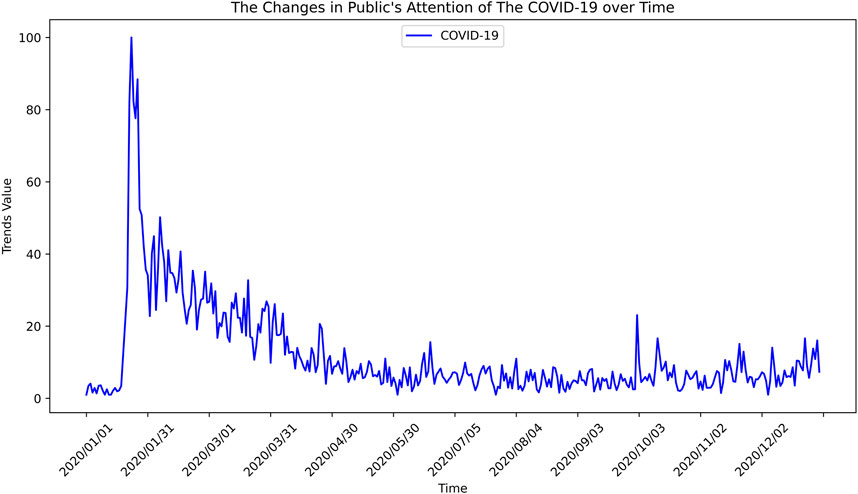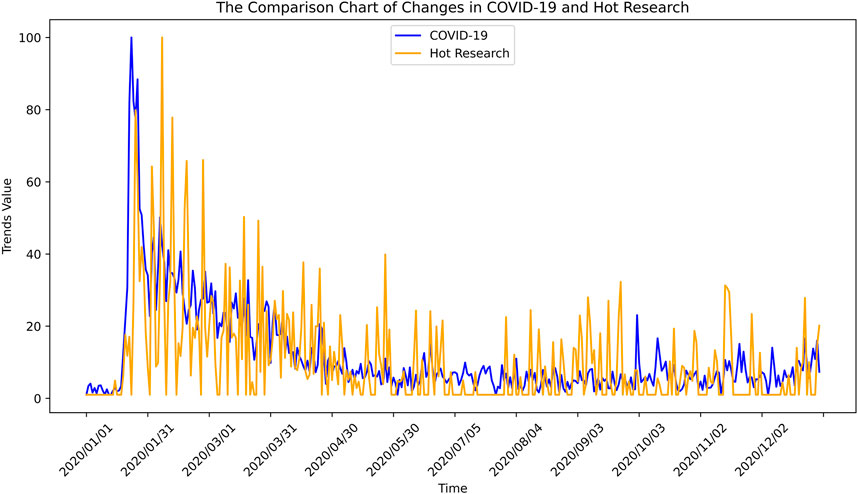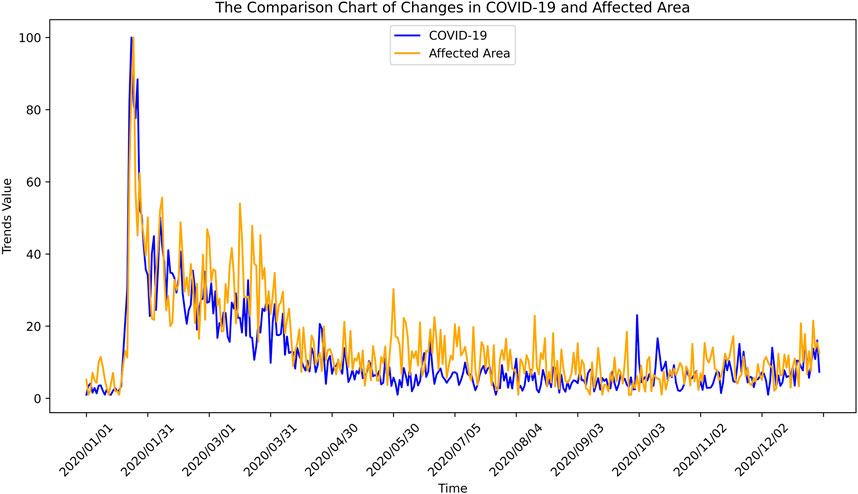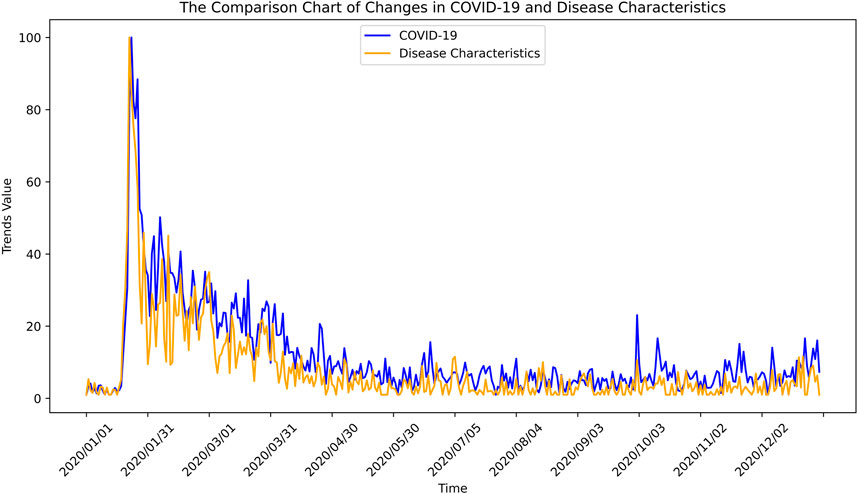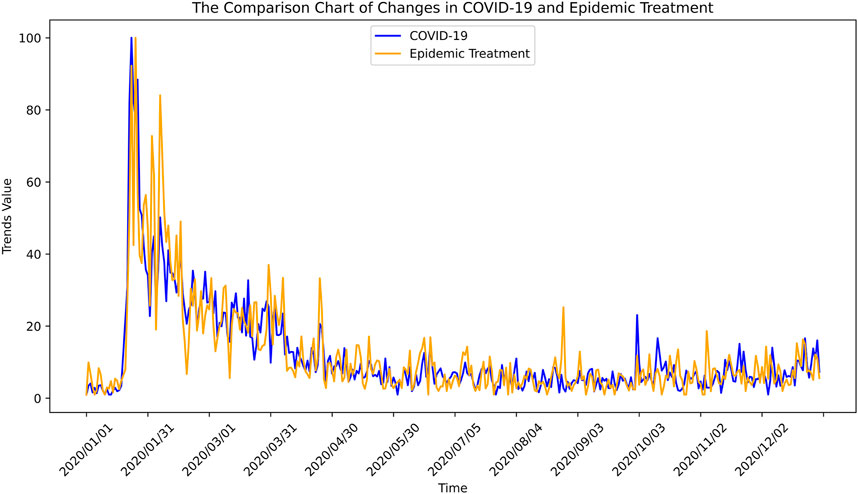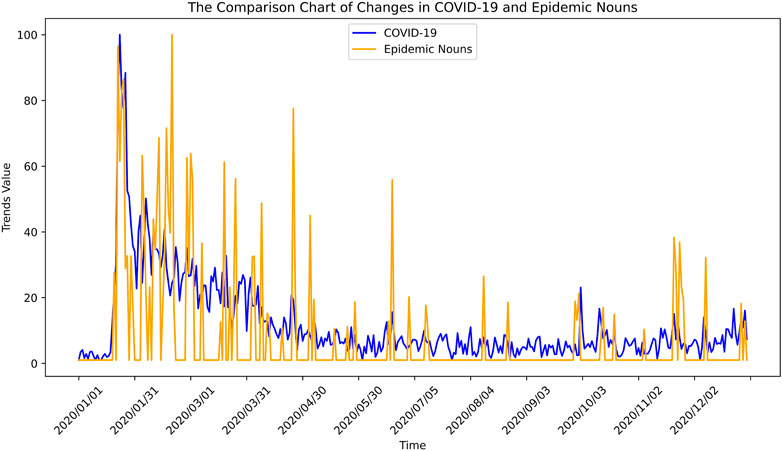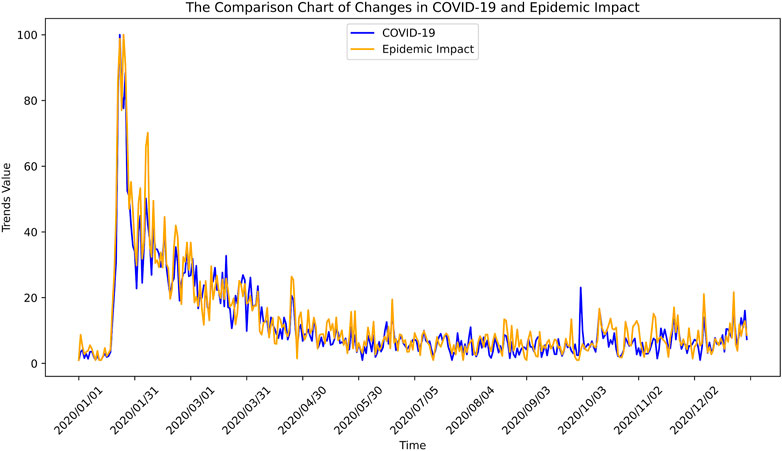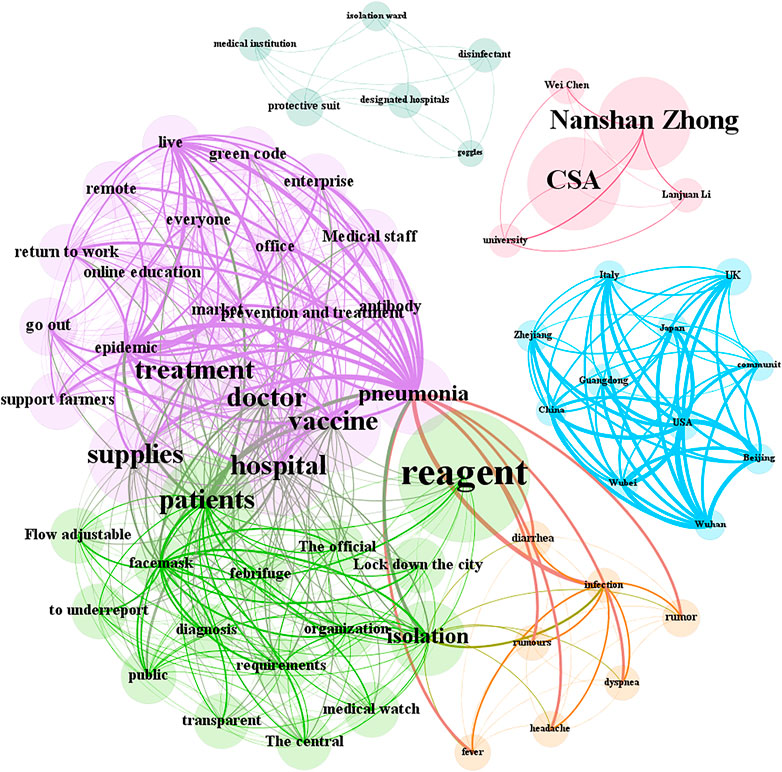Analysis of public information demand during the COVID-19 pandemic based on four-stage crisis model
- 1Department of Computational Mathematics, School of Mathematics, Jilin University, Changchun, China
- 2Jilin National Applied Mathematical Center, Jilin University, Changchun, China
- 3Department of Mathematics, Southern University of Science and Technology, Shenzhen, Guangdong, China
- 4Department of Epidemiology and Biostatistics, School of Public Health, Jilin University, Changchun, China
At the end of 2019, the outbreak of the Corona Virus Disease 2019 (COVID-19) became a grave global public health emergency. At that time, there was a lack of information about this virus. Nowadays, social media has become the main source for the public to obtain information, especially during the COVID-19 pandemic. Therefore, in order to know about the public of information demand after the outbreak, the research collects the data of hot search on Sina-microblog from 1 January 2020 to 30 December 2020, and then conducts data mining by combining text processing with topic models. Then we show the topics mined in the knowledge map. The results show that with the outbreak of the COVID-19, people’s attention to the topics related to the epidemic reaches the maximum in a short time, and then decreases with fluctuation, but does not disappear immediately. Some topics fluctuate violently due to the emergence of special events. The results conformed to the four-stage crisis model in the emergency management. We analyze the role of social media in four stages for this. The findings of this study could help the government and emergency agencies to better understand the main aspects, which the public’s concern about COVID-19, and accelerate public opinion guidance and emotional reassurance.
1 Introduction
From December 2019, there were many cases of pneumonia caused by unknown causes in Wuhan. After inspecting, it was found that the pneumonia was caused by virus, which did not conform to any known virus. On 7 January 2020, the China National Health Commission confirmed that this new virus belongs to coronavirus. On 12 January 2020, the World Health Organization (WHO) named it “2019-nCov”. On 11 March 2020, the director general of the WHO announced that COVID-19 constituted a global pandemic. Coronavirus is a large family of viruses, including severe acute respiratory syndrome coronavirus (SARS-CoV) and Middle East respiratory syndrome coronavirus (MERS-CoV), which previously caused serious consequences to humans. The SARS-CoV first appeared in South China in 2002, then spread to Southeast Asia and even the world [1]. Saudi Arabia reported the first case caused by MERS-CoV on September 2012 [2]. When these new viruses appear, we don’t know the mechanism of action on human body. When they begin to causing adverse effects on human health, people actively search for information through various channels to prevent it.
The emergence of public health emergencies has promoted the research of crisis communication theory. The representative of crisis communication theory is Fink’s four-stage analysis theory [3], which includes symptom period, outbreak period, continuous period and recovery period. Under the guidance of the four-stage crisis model, Zheng et al. [4] studied and analyzed the characteristics and functions of social media in emergencies. Zhang et al. [5] found that social media is the main channel for information dissemination of the COVID-19. It has become a key node for information dissemination at all stages of the development of crisis risk dissemination. Under the background of the rapid development of Internet technology, social media has become an important medium to participate in emergencies.
In 1971, the first e-mail was born and social media began to develop. After that, all kinds of early search engines and real-time communication tools appeared in people’s vision. In 1999, the emergence of blog tools made social media gradually became the main channel for people to obtain information. After the outbroke of COVID-19, social media became an important platform for the public to understand the trend of the epidemic, Especially. Based on the public’s huge demand for epidemic information, it has become the focus of recent research that the main content of the public’s information demand in public health emergencies. WONG et al. [6] found people generally hope to obtain information on influenza prevention and treatment during the H1N1 influenza pandemic. MAJID et al. [7] also analyzed the information needs of the public during the H1N1 influenza pandemic and the results show that the public pay high attention to symptoms, causes of infection, preventive measures and treatment methods. FU et al. [8] analyzed the public discussions on the Zika virus. They mainly focused on the impact of the epidemic on society, the response of the government and relevant departments, the negative health of vulnerable groups, transmission routes, and case reports, etc. Gao et al. [9] found that during the SARS pandemic, the public paid more attention to social activities related to the SRAS epidemic. Existing studies have shown that timely understanding of public opinion plays an important role in responding to public crises.
After the outbreak of COVID-19, research on the COVID-19 emerged one after another. Li et al. [10] analyzed the hot spots of “COVID-19 in traditional Chinese medicine” on Sina-microblog during the COVID-19 pandemic, which showed that the traditional Chinese medicine played an important role in maintaining social stability. Shen et al. [11] analyzed the strategy of refuting rumors in public emergencies of the COVID-19 by studying hot events of Sina-microblog. Han et al. [12] divided the public demand classification of information disclosure of public health emergencies into basic demand, expectation demand, charm demand and irrelevant demand. While Yang et al. [13] studied the impact mechanism of public information needs on crisis management in public health emergencies, found that the public’s information needs during public health emergencies were mainly centered on four aspects including risk perception, behavioral norms, emotions, and behavior. Liu et al. [14] through studying the influencing factors the public trust to media during the COVID-19 pandemic, provided a reference for the government’s risk communication and information behavior guidance to the public.
Existing research generally focus on the impact of the epidemic from a pre-selected direction, but there will be a deviation between the artificially selected theme and the actual public information demand. To this, from the perspective of data, our study combines text processing with topic model to design a novel and effective strategy to mine public attention hot spots from unstructured text information. Specifically, we first use text processing to clean up unstructured data, then sort out many topics related to the COVID-19 by using topic model, merge the topics in the processed data in final. Our method is more in line with the real information needs of the public during the epidemic pandemic. Existing research is also very difficult to be sure of the relationship between multiple themes, because it is almost impossible to know which themes have a relationship in the actual needs of the public in advance. In fact, during the COVID-19 pandemic, the public’s information needs are various and change with the development of the epidemic. In this case, we can’t rely on the traditional public opinion analysis methods to mine effectively. At the same situation, our method can extract the possible correlation between the themes reflected in the data, so as to timely obtain the change of the public’s perception and attitude towards the epidemic.
Our research introduces the four-stage crisis model in the result analysis stage, which helps us well to analyze how people’s concerns change during the epidemic, and finds abnormal points with severe changes in attention. Then the government and health offices can take corresponding measures in case of sharp fluctuations in public attention. For example, the government can clarify and suppress the rumors when the rumors cause fluctuations timely, or give appropriate guidance and comfort to the public when the negative emotions cause fluctuations.
This paper consists of four sections. In Section 2, we conduct data processing and data mining by using many algorithms like Latent Dirichlet Allocation (LDA). In Section 3, we show the results of each stage of data mining and explain these results in detail. A discussion based on our results is given in Section 4.
2 Materials and methods
2.1 Materials
Our research is based on Sina-microblog, one of the most popular social media platforms in China [15]. The platform had over 523 million active users each month and 229 million active users each day in 2020. It has also many modules, including all kinds of data, among which the hot search data is the focus of public attention. But the Sina-microblog platform can’t find historical data. We get the historical data from a website named enlightent where the Sina-microblog hot search data is stored. We collect the top 100 Sina-microblog hot search data every day in 2020, from 1 January 2020 to 31 December 2020, a total of 35,901 pieces of data. The metadata involved includes fields such as title, time, the number of searches, and ranking.
In order to improve the efficiency and accuracy of data mining, we preprocess the hot search data before analysis. We perform Chinese word segmentation [16] based on the maximum matching of strings on the title field of the hot search data to extract the main content of the text, and use stop words filtering to improve the word segmentation effect. Next, we make statistics on the word frequency on the results of word segmentation of hot search data. On the one hand, the word frequency statistics is used to perform simple statistics on public information needs. On the other hand, it is used to generate word co-occurrence matrices in next.
2.2 Methods
2.2.1 Topic dictionary
Baidu Index and Google Trends have been able to analyze the keywords directly, which can effectively reflect the change of the attention to one keyword, but this method can’t realize the processing of keyword sets. In order to achieve the purpose of processing multiple keywords at the same time, we introduce a custom dictionary [17] to represent the keyword set, where the keyword set is named as topic. The hot search data contains a lot of data unrelated to the COVID-19. In order to remove these unused data, we use the keyword set about epidemic for preliminary screening. First, we create a custom dictionary based on the relevant vocabulary and English expressions of the COVID-19 approved by the National Major Translation Project Approval Working Committee led by the China International Publishing Group (CIPG). Here we name it COVID-19 custom dictionary. Then, we use the python to screen the hot search data with the help of the COVID-19 custom dictionary.
However, with the help of the COVID-19 custom dictionary, it can only describe the overall situation of the public’s attention to the COVID-19. In fact, the public’s information needs during the epidemic include many aspects such as pathological symptoms, government measures, medical progress, etc. Here, we would also like to mention in passing that the dictionary searching has been proposed and implemented in different contexts (Li et al., 2013a), (Li et al., 2013b), (Li et al., 2014), and (Li and Liu, 2015).
2.2.2 Multidimensional scaling
Multidimensional scaling [18] is a statistical research method that can cluster samples or variables in multiple dimensions based on the similarity or dissimilarity. According to the above, we have established custom dictionaries for the keyword sets of different aspects about the COVID-19, which we name topics here. But the content of the topics is complex including the inclusion and repetition relationship. This paper uses multidimensional scaling analysis to cluster these topics to show topics distribution.
Before defining topic distance, which is the core of multidimensional scaling method, we need to define the topic vector. One of our purposes is to research the changes in the public’s attention to different information needs in the hot search data. Therefore, we calculate the correlation between the topic and the hot search data as the topic vector. Different ways of defining distances often lead to different effects. This paper uses Euclidean distance to define the correlation between two topics. Next, we construct co-occurrence matrix about topics. We have made twenty-nine topics based on different aspects of the COVID-19. Then we convert them into topic vectors respectively. Finally, we calculate the distance between the topic vectors and construct co-occurrence matrix as the input of multi-dimensional scales. The clustering results only show the distribution of topics. We need to further dig out the specific content of each distribution.
2.2.3 LDA theme model
The LDA theme model [19] is a statistical model that discovers the hidden themes in the text through unsupervised learning methods. After multi-dimensional scaling analysis of the topics, we obtain the distribution of the topics, but the specific clustering results can’t be obtained. This paper, by combining the distribution of the topic, uses the LDA theme model to further explore the hidden themes in the topic.
The LDA theme model usually performs topic mining on the decomposed vocabulary of the text, and the key is to mining lies in the generated word bag. However, the topic is a vocabulary collection in this paper. Therefore, before applying the LDA topic model, it is necessary to expand the topic into a word bag. But, in the previous paper, we don’t count the word frequency of the title field in the hot search data by using the epidemic custom dictionary. Then we expand topics into word bags by using the data of filtering by COVID-19 custom dictionary, and we use the LDA theme model to mine themes in these word bags.
The results show that this method can’t achieve better results in topic mining, which directly uses word frequency to expand into a bag of words. Because, only the frequency of the words in the topic is considered in the hot search data, the number of occurrences is not considered in each theme. This paper uses TF-IDF instead of simply using word frequency, which means that the importance of a word is proportional to the number of times appearing in the current text. Meanwhile it is inversely proportional to its frequency in all texts. The results show that, after using TF-IDF instead of word frequency to expand the topic into a bag of words, we get better results.
2.2.4 The evolution of themes
During the COVID-19 pandemic, the public information needs on various themes is not constant, and it is unknown whether there is a relationship of each theme. The knowledge map is a good way to present this relationship. In essence, it is a semantic network that reveals the relationship between entities. This paper uses the knowledge graph analysis method [20] based on the co-occurrence matrix. Then, the evolution relationship among topics can be mined by constructing the correlation between the main keywords of each theme. That we can analyze the public information needs better.
2.2.5 Four-stage crisis model
In 1986, Steven Fink put forward the analysis theory of the four-stage model in crisis communication for the life cycle of the enterprise crisis. Later, it became one of the major models accepted by the academia in the analysis method of the crisis management stage. Based on the four-stage crisis model, this paper analyzes the outbreak of the COVID-19, a major public health event. On the one hand, it can help us to analyze the changes and characteristics of the topics concerned by the public in each stage, on the other hand, we can better understand the role that social media can play in each stage.
3 Results
We conduct the preliminary screening on the hot search data with the help of the COVID-19 custom dictionary. Here we use the “cnsenti” one package of python for data analysis. Specifically, we set the parameter “pos” in the model to our COVID-19 custom dictionary, and focus on the results corresponding to the parameter “pos” in the subsequent analysis. In order to refuse to merge the dictionary provided by the model itself, we set the parameter “merge” to false. Finally, a total of 3,302 pieces of data related to the COVID-19 are screened out, accounting for about 10% of the total. This also shows that the COVID-19 epidemic has received deep and wide attention. And we plot the time series distribution of the data after the preliminary screening, as shown in Figure 1.
The horizontal axis represents time, and the vertical axis represents the number of searches. Due to the large number of searches in the hot search data and the changing value that fluctuates too much, it makes the curve very difficult to draw. It will make the trend of changing obvious and the subsequent analysis work beneficially if we map the number of searches to the interval of [0, 100].
Then we use the statistical software SPSS 24 to do multi-dimensional scale analysis on the topics, under the stress convergence of 0.001, the minimum stress value of 0.005, and the maximum number of iterations of 30. We can see from the result that some topics are clustered together, because these topics are very likely to each other, and these clustered topics have a cluster center. Therefore, through multi-dimensional scaling analysis and clustering of the twenty-nine topics used in this paper, six cluster centers can be determined. That means, six themes are hidden in the twenty-nine topics. Then, we can get six themes after integrating the twenty-nine topic custom dictionaries. Finally, we will get the new topic custom dictionary named themes.
In order to get the content of these six themes, in the LDA model, we use TF-IDF instead of word frequency to expand the topic into a bag of words, dig out six hidden themes in the bag of words, and organize the themes and their main keywords to be shown in Table 1. From the table, we can see that the hot research theme includes some medical experts and institutions fighting against the epidemic, and the epidemic nouns theme includes some professional nouns, which rarely appears before. For other themes, some contents often appear in people’s vision.
Next, we compare the changes in the attention of each theme with the changes in the overall attention of the COVID-19 and use the blue line to represent the change in attention to COVID-19. The comparison chart is as follows in the figures. They are Figure 2 for hot research theme, Figure 3 for affected area theme, Figure 4 for disease characteristics theme, Figure 5 for epidemic treatment theme, Figure 6 for epidemic nouns theme and Figure 7 for epidemic impact theme. The changes in the attention of four themes, affected area, disease characteristics, epidemic treatment, and epidemic impact, is almost consistent with the change in the overall attention of the COVID-19. While the other two themes appear severe fluctuation, there may have some special reasons.
For the generation of the knowledge graph, we use the word frequency statistics in the previous article to construct the co-occurrence matrix between the main keywords in each theme, and generate it on Gephi 0.9.2 which is a information data visualization tool. Finally, we construct a total of sixty-six core keywords in themes, five hundred and forty-two relationships, average path length of one point four seven two, and a network diameter of two. The specific results are shown in Figure 8. From the figure, we can see that there are much close connections between the three themes, the epidemic treatment theme, the disease characteristics theme and the epidemic impact theme. However, the other three themes seem relatively independent.
4 Discussion
Previous studies have analyzed the changes of public attention on the previously selected topics, which has some deviations between the information needs and the facts. Our method is more authentic from the actual data and includes multiple topics at the same time. In addition, there are some new findings in our research.
In the comparison charts, the changes in the attention of the four themes are basically the same, involving affected area, disease characteristics, epidemic treatment, and epidemic impact. This is in line with the four-stage crisis model. According to the inflection point of the changes of public attention, we divide the epidemic transmission cycle into four stages. The first stage, the symptom period, the public pays less attention to this theme and the curve is temporarily flat. The second stage, the outbreak period, the curve suddenly rises, the attention sharply increases, and the end point can reach the peak of attention at this stage. The third stage, the continuous period, the attention begins to show a downward trend, and the curve fluctuates downward. The fourth stage, the recovery period, the curve continues to spread at a relatively lower position, and the end point would not appear, which means the focus on the subject does not decrease to zero. The reasons for the four stages are as follows. We think it may be that the outbreak of the COVID-19 attracts strong public attention in a short period of time, and aspects closely related to the COVID-19 are also searched a lot at the same time. As time goes on, attention of the COVID-19 and related aspects gradually decreases. Although it fluctuates, but never reaches the peak of attention during the outbreak. The occurrence of key events in various themes, leading to the generation of such fluctuations. As a result, due to the local epidemic of the COVID-19, the public’s attention to the epidemic will not disappear in a short time.
We further describe the characteristics of each stage and what can social media do to help the public. The first stage, the epidemic is in the quantitative change stage of the outbreak, which is not easy to be detected. If social media can find and effectively transmit information in time, the public can take better precautions. The second stage, is the period when the epidemic is causing the greatest harm to society. If the media can collect the detailed information, coping style and possible trends of the epidemic for the first time, these can meet the information needs of the public, eliminate public cognitive bias and promote the public to respond actively. The third stage, social media can supervise and correct all kinds of improper and wrong remarks and behaviors, stop the spread of rumors, and guide the public to the favourable direction of preventing epidemic. The fourth stage, through authoritative information and scientific information, social media can timely remove public doubts, guide people’s all-round reflection and increase people’s experience in dealing with similar events in the future.
For hot research theme and epidemic nouns theme, the attention of the two themes is near zero in some time. On the one hand, during the time, the public pay little attention to these two themes, which can’t reach the hot search range. On the other hand, these two themes also have particularities. Keywords in hot research theme and epidemic noun theme are outside the scope of the public daily attention. Only when events related to such keywords occur, they will appear in the public view for a short time, and the fluctuations caused by such keywords are usually greater. On the evening of January 20, academician Nanshan Zhong came to the important judgment of “human to human” after repeated thinking and verification, which made the name of academician Nanshan Zhong appear in the public again. Because the occurrence of the same event caused the appearance of special keywords, these related keywords occupy the public’s attention in a short period of time.
Meanwhile, there are many fluctuations caused by fake news. In the evening of January 31, a news that Chinese patent medicine shuanghuanglian oral liquid can inhibit the COVID-19 spread like wildfire, causing high public attention. Then, Shuanghuanglian oral liquid drugs were sold out. The generation of false news stems from the public crisis psychology, which aggravates the public passion. It is necessary for the government and relevant offices to clarify the authenticity of the news and guide the public mood towards positive and healthy attitude.
The knowledge map in Figure 8 shows that, the themes are unrelated with the others, including hot research themes, epidemic nouns themes, and affected area themes, because of the appearance of keywords in these themes is relatively independent. Meanwhile, their keywords are also hard to connect with other theme keywords. However, the themes are not completely unconnected. As the core of the epidemic, “pneumonia” appears in multiple themes. Among them, there are more connections among the epidemic treatment theme, the disease characteristics theme, and the epidemic impact theme. Therefore, it is exceedingly possible that the epidemic treatment theme plays a bridge role when the public pays attention to the change of theme. In addition, the different themes could also appear in a certain event at the same time. In the hot search event, the keywords “Enterprise resumption of work must distribute masks for employees”, “resumption of work” the keyword in epidemic impact theme and “Masks” the keyword in epidemic treatment theme and treatment appear at the same time. The knowledge graph reveals the connection and change among themes, providing the government and relevant departments with predictions of changes in public attention in the next stage, and the direction to guide public sentiment.
5 Conclusion
Our study combines text processing and topic mining, mines the themes relevant to COVID-19 in the Sina-microblog hot search data, and analyzes the changes in the attention of each theme. The results shown that six epidemic themes have been mined, including hot research, affected area, disease characteristics, epidemic treatment, epidemic nouns, and epidemic impact. Among them, the changes of attention to four themes conform to the four-stage crisis model, which include epidemic impact, affected area, epidemic treatment, and disease characteristics. We believe that if social media does something to guide the public in the four stages, it is meaningful to prevent and control the epidemic. In addition, the key words were exposed to the public suddenly, which caused many violent fluctuations for the other two themes. The government and relevant offices should pay attention to the fluctuations and appropriately take corresponding measures. Finally, we show the relationship among themes in the knowledge graph, and speculate the possible changes in the public’s attention of epidemic treatment, epidemic impact and disease characteristics. This is meaningful for predicting new epidemic theme of concern in next. The above results have greatly significance on the public opinion analysis and early warning of major public health emergencies in the future.
6 Limitations and prospect
Our research is based on the Sina-microblog, the world’s largest Chinese social networking platform. The platform contains a large number of various users, who are active on the platform every day and produce a large number of real-time updated data, which makes the platform more responsive to the people’s information needs. So we choose this platform as the main research object. We will consider to combine the data of other platforms for collaborative research. In the knowledge map analysis, the changes between epidemic themes are studied in stages. They are both supplementary aspects of future work.
7 Permission to reuse and copyright
Figures, tables, and images will be published under a Creative Commons CC-BY licence and permission must be obtained for use of copyrighted material from other sources (including re-published/adapted/modified/partial figures and images from the Internet). It is the responsibility of the authors to acquire the licenses, to follow any citation instructions requested by third-party rights holders, and cover any supplementary charges.
Data availability statement
The original contributions presented in the study are included in the article/supplementary materials, further inquiries can be directed to the corresponding authors.
Author contributions
JJ and SL had the original idea for the study. YF, JJ, and SL provided valuable insight regarding the methodological approach and organization of the manuscript. YF carried out the theoretical analysis. YF and JL reviewed the consistency of data included in the article. YF and SL wrote and revised the manuscript. All authors read and approved the final manuscript.
Funding
Our research was supported by National Natural Science Foundation of China (Grant No. 11901234), the Fundamental Research Funds for the Central Universities, JLU (Grant No. 93K172020K27), Natural Science Foundation of Jilin Province (Grant No. 20210101481JC), and Shanghai Municipal Science and Tenchnology Major Project (Grant No. 2021SHZDZX0103). Guangdong NSF Major Fund No. 2021ZDZX1001, the Shenzhen Sci-Tech Fund No. RCJC20200714114556020, JCYJ20200109115422828 and JCYJ20190809150413261.
Conflict of interest
The authors declare that the research was conducted in the absence of any commercial or financial relationships that could be construed as a potential conflict of interest.
Publisher’s note
All claims expressed in this article are solely those of the authors and do not necessarily represent those of their affiliated organizations, or those of the publisher, the editors and the reviewers. Any product that may be evaluated in this article, or claim that may be made by its manufacturer, is not guaranteed or endorsed by the publisher.
References
1. Guan Y, Zheng BJ, He YQ, Liu XL, Zhuang ZX, Cheung CL Isolation and characterization of viruses related to the sars coronavirus from animals in southern China. Science (2003) 302:276–8. doi:10.1126/science.1087139
2. Zumla A, Hui DS, Perlman S. Middle East respiratory syndrome. The Lancet (2015) 386:995–1007. doi:10.1016/S0140-6736(15)60454-8
3. Steven F, Association AM. Crisis management: Planning for the inevitable. New York, NY: Amacom (1986).
4. Zheng Y. The public opinion guidance of microblog in emergences. Ph.D. thesis. Chongqing, China: Chongqing University (2016).
5. Zhang K. The core role and communication mechanism of social media in ncp crisis risk communication. Journalism Commun Rev (2020) 10. doi:10.14086/j.cnki.xwycbpl.2020.03.003
6. Wong LP, I-Ching S. Public sources of information and information needs for pandemic influenza a (h1n1). J Community Health (2010) 35:676–82. doi:10.1007/s10900-010-9271-4
7. Majid S, Rahmat NA. Information needs and seeking behavior during the h1n1 virus outbreak. J Inf Sci Theor Pract (2013) 1:42–53. doi:10.1633/jistap.2013.1.1.3
8. Fu KW, Liang H, Nitin S, Ho TZT, Patrick I, Chun-Hai FI. How people react to zika virus outbreaks on twitter? A computational content analysis. Am J Infect Control (2016) 44:1700–2. doi:10.1016/j.ajic.2016.04.253
9. Gao W, Chenand Z, Wangand Y, Shi Z, Yangand X, Zhang J. The dynamic analysis of public concern during sars epidemic period. Chin Ment Health J (2003) 17:594–6.
10. Li Y, Zhao H, Su L. Analysis of the weibo topic ”cCovid-19in traditional Chinese medicine” during the coCovid-19pidemic – microblog topic mining based on lda model. Asia-Pacific Traditional (2020) 3.
11. Shen Q. Research on “mediated” vicarious traumatization in major epidemics. In: International Conference on Mental Health and Humanities Education (ICMHHE 2020). Amsterdam, Netherlands: Atlantis Press (2020). p. 192–5.
12. Han W, Chen Y, Chen A. Research on public’s demands for information disclosure of public health emergencies based on kano model. Inf Studies:Theory Appl (2020) 43:9–16.
13. Yang K, Yang C, Zhu Q. Research on public information demand and crisis management of public health emergency based on social media. Inf Studies:Theory Appl (2021) 44:59–68.
14. Liu Z, Hao Y, Ning L, Niuand J, Bi X, Zhang P, et al. Novel coronavirus pneumonia during the period of public media trust analysis of factors. China public health (2021) 37:1107–12.
15. Yin F, Pang H, Xia X, Shao X, Wu J. Covid-19 information contact and participation analysis and dynamic prediction in the Chinese sina-microblog. Physica A: Stat Mech its Appl (2021) 570:125788. doi:10.1016/j.physa.2021.125788
16. Pei J. A dictionary-based maximum match algorithm via statistical information for Chinese word segmentation. Int J Electron Inf Eng (2020) 12:24–33.
17. Deepa D, Tamilarasi A. Sentiment analysis using feature extraction and dictionary-based approaches. In: 2019 Third International conference on I-SMAC (IoT in Social, Mobile, Analytics and Cloud)(I-SMAC). Palladam, India: IEEE (2019). p. 786–90.
18. Zhang X, Zhou Y, Zhou F, Pratap S. Internet public opinion dissemination mechanism of Covid-19: Evidence from the shuanghuanglian event. Data Tech Appl (2021) 52. doi:10.1108/DTA-11-2020-0275
19. Yang X, Wu S, Xia H, Yu X. Public opinion analysis of Covid-19 epidemic using topic mining and emotion analysis. Comput Era (2020) 8:31–36.
20. Yi W, Wang Y, Tang J, Xiong X, Zhang Y, Yan S. Visualization analysis on treatment of coronavirus based on knowledge graph. Zhonghua wei Zhong Bing ji jiu yi xue (2020) 32:279–86. doi:10.3760/cma.j.cn121430-20200225-00200
21. Jingzhi Li, Hongyu Liu, Zaijiu Shang, Hongpeng Sun, et al. Two Single-Shot Methods for Locating Multiple Electromagnetic Scatterers. SIAM Journal on Applied Mathematics (2013a) 73(4):1721–1746.
22. Jingzhi Li, Hongyu Liu, Qi Wang, et al. Locating Multiple Multiscale Electromagnetic Scatterers by a Single Far-Field Measurement. SIAM J. Img. Sci. Society for Industrial and Applied Mathematics. (2013b) 6(4):2285–2309.
23. Jingzhi Li, Hongyu Liu, Jun Zou, et al. Locating Multiple Multiscale Acoustic Scatterers. Multiscale Modeling \& Simulation. (2014) 12(3):927–952.
Keywords: COVID-19, social media, information demand, topic model, four-stage crisis model, emergency management
Citation: Fang Y, Jia J, Li J and Liu S (2022) Analysis of public information demand during the COVID-19 pandemic based on four-stage crisis model. Front. Phys. 10:964142. doi: 10.3389/fphy.2022.964142
Received: 08 June 2022; Accepted: 07 July 2022;
Published: 25 July 2022.
Edited by:
Hui-Jia Li, Beijing University of Posts and Telecommunications (BUPT), ChinaReviewed by:
Wei-Xing Zhou, East China University of Science and Technology, ChinaHongyu Liu, City University of Hong Kong, Hong Kong SAR, China
Copyright © 2022 Fang, Jia, Li and Liu. This is an open-access article distributed under the terms of the Creative Commons Attribution License (CC BY). The use, distribution or reproduction in other forums is permitted, provided the original author(s) and the copyright owner(s) are credited and that the original publication in this journal is cited, in accordance with accepted academic practice. No use, distribution or reproduction is permitted which does not comply with these terms.
*Correspondence: Jingzhi Li, lijz@sustech.edu.cn; Siyu Liu, liusiyu@jlu.edu.cn
 Yabo Fang1
Yabo Fang1  Jiwei Jia
Jiwei Jia Siyu Liu
Siyu Liu